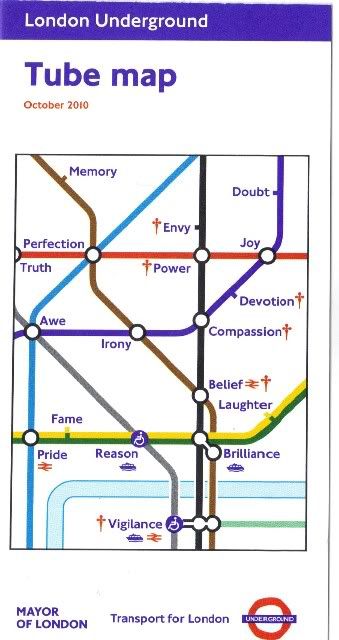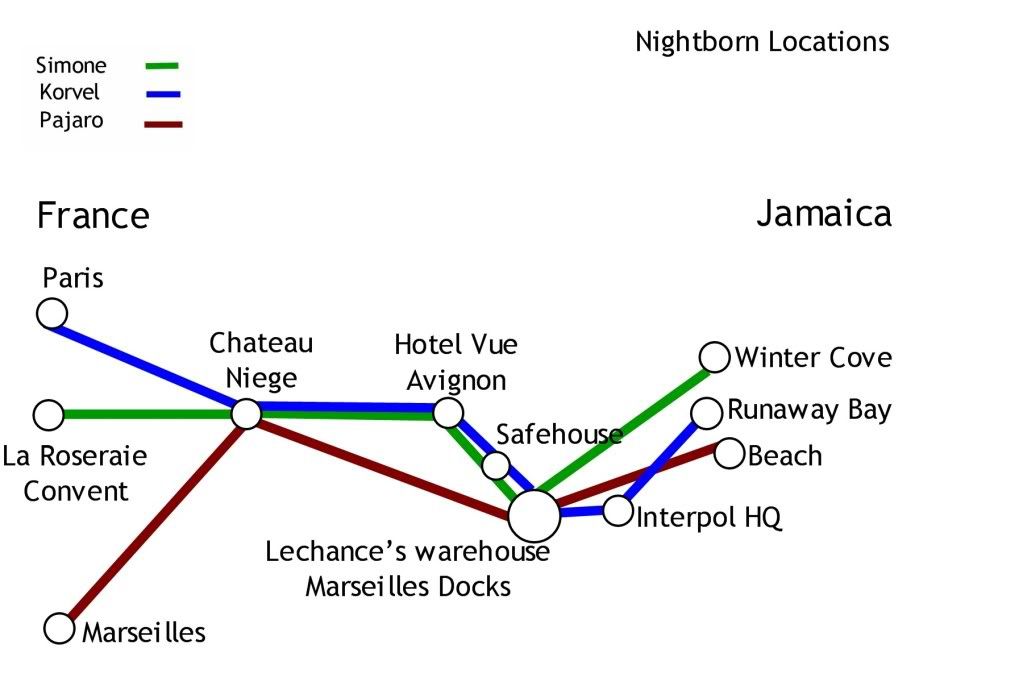 I love the cover of this map for the London Underground (click to see larger version), which was obviously designed by someone with a wry sense of humor. Wouldn't the journey be so much simpler if we could pick up a map that shows us in advance all of life's endless interchanges?
I love the cover of this map for the London Underground (click to see larger version), which was obviously designed by someone with a wry sense of humor. Wouldn't the journey be so much simpler if we could pick up a map that shows us in advance all of life's endless interchanges?In the real world we can only wish, but in story worlds we plotters map out in advance what happens to our characters. We usually do this by writing outlines, synopses, chapter summaries, storyboards, index cards, filling in templates and what have you (I've gone so far as to outline a story like a wiring diagram.) I've never thought of mapping out a story like an actual map, probably because cartography is a beautiful, complex art that is completely beyond me. If you think of story like a simple line map for an underground or subway system, however, it seems far less intimidating.
The transit lines would be characters, I think, and the interchanges (stops along the way) would have to mark different points or elements in the story. To make it a useful tool, I'd want to map it out chronologically, starting the lines at chapter one and ending at the final chapter. One could draw/superimpose them on an actual real world map (assuming that would somehow be helpful), but to keep things from getting too complicated I'm going to start with a plain white background.
Here's my first try using three characters and the settings where they intersect in Nightborn:

This could be a lot of fun to do with story elements other than locations or settings, too. A map with transit lines of all the novel characters and what makes them intersect or split away from each other would be fun to put together. Or imagine exploring the progression of a relationship between two characters this way while using the interchanges as events, emotional shifts, the effects of other characters on the relationship, etc.
I don't think you have to use a photo shop program for this; you can draw it in colored markers/pencils on paper, or use a whiteboard with those dry-erase markers (which would probably be easier to revise.) If you're really creative you could probably do something similar with ribbons, push pins and a big cork board, too.
I'm going to keep tinkering with this and see what I can put together. In the meantime, what do you guys think? Would this be something that would work as an outlining tool for you, or is it too weird to be practical?

This is also an excellent way to build (or reinforce) a memory palace.
ReplyDeleteI am using a similar method currently.
http://www.urbanrail.net/ is an excellent resource. This is basically a global listing of subway/light rail/tram systems on 6 continents.
So you would not only be able to find a subway map that fits your sense of scale and style, you could also extend existing transportation lines for near-future writing complementary with where you would expect an existing city to be in 10-20-30 years.
Or build subway lines on other worlds (be it Sol or otherwise, it's a big universe, cobber...) and attach character development, significant events, etc. along with physical landmarks. Continuity is essential, right?
One thing I always enjoyed about historical fiction, or other forms of fiction is when authors include maps of where their stories take place.
And who knows, maybe you get to live in the worlds you create someday...
I think that could be really useful. Most of my brainstorming/outlining gets done in plain notebooks, and so occasionally it is difficult to remember every little interaction that characters have with each other. Especially since I have an indecent number of projects.
ReplyDeleteHaving something like this to glance at to remind myself that those characters already met, already talked, already hate each other, etc. I'd probably color code the "stops" - a different color for being at the same location but without interaction, for a romantic interlude, for a heated or adversarial exchange, or any other fairly common occurrence I have in my books.
Keep building on it. I'd love to see the outcome. : )
I'd probably stick to the good old write-a-plan sort of thing, though I'd be cool with creating a mind-map or flow-chart or storyboard for certain aspects of a novel. Something else I've thought of doing since studying media as one of my final subjects is to create a narrative intensity chart, and I chart the intensity of different aspects of the plot against each other. There are a lot of different ways for writers to do things, but it all boils down to the individual's strengths and preferences. Thanks for blogging, LOVE that first map!
ReplyDeleteThat's really cool, Lynn. I'm not a visual person, but I could see that really helping in a complex multi-character story. (ps--did you get my email re the character interview? xxoo)
ReplyDeleteI do something similar, but I call it "beanstalking," since my jumping-off point involved roots and sprouts and twining together and branching off and so forth. It looks a lot messier on paper (more like a multi-train pileup than a route map), but I don't have to look at the tangled thing once I start establishing the connections in my head.
ReplyDeleteI'm not a plotter. I wish I was. It seems like any outline in any way, shape or form ends up either being scrapped by me because the direction turns so radically from the story, or I feel like I've outlined so minutely that I've told the story and I lose interest in it.
ReplyDeleteYes, please :o) I want to see what the end result is of this. Maybe it's something I can use.
Actually, I've tried something like this with mapping out the threads and where they interconnect. Sadly, it ended up unbalancing the story because each thread gained so much weight that I could have written four books covering the same timeframe and will the same characters. But for people who have issues with finding subplots (as opposed to subplots running amok :)), I think it should be useful.
ReplyDelete